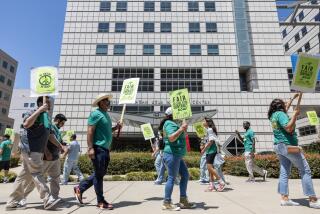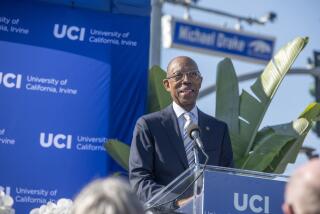Baisden, Retiring Soon, Recalls Some Battles : UCI’s Extension Dean Cooked Up a Heady Mixture
- Share via
The courses he directs represent the latest in high-tech education
--classes in artificial intelligence, electronic music and hazardous-materials management.
But Richard N. Baisden, the silver-haired founding dean of UC Irvine Extension, can speak with equal ease about education in another era--the late 1950s and early 1960s, when corporate offices were replacing lima bean fields in Orange County.
At the time, Baisden was an associate dean in charge of UCLA Extension programs for “outlying areas,” Orange County among them. And so in 1965, when Daniel G. Aldrich, UCI’s first chancellor, needed someone to introduce the University of California’s cosmopolitan style to a growing county, he hired Baisden.
Both Aldrich and Baisden recounted some of UCI’s early history at a University Club reception Thursday for the 65-year-old dean, who will retire at the end of this month.
Still, Baisden admitted in remarks to 150 friends, he almost didn’t take the job.
For early in his experience with UCLA Extension, he tangled with Orange County’s right wing. In a 1962 incident, when Baisden scheduled a film series at the Grove Theatre in Garden Grove, angry residents complained about a Charlie Chaplin film, asking: “Why are we having one of those Commie films?”
And three years later, when the extension program featured a speech by Venezuela’s first president, Romulo Betancourt, “some right-wing group” objected, Baisden recalled. Not only did the group picket the lecture, but “every time Betancourt used the word ‘liberty’ or ‘freedom,’ these guys blew whistles” to drown him out.
“Welcome to Orange County,” the dean recalled with a laugh.
So when Aldrich asked him to be dean of UCI Extension, “I accepted--but with reservations. . . . In a way, it was like taking a (U.S.) State Department post in Iran.”
Luckily, Orange County was more diverse than Baisden’s first impressions suggested. For over the next 23 years at UCI, he proceeded to build one of the leading continuing education programs in the state, UC administrators say. UCI Extension programs today include courses in management, health care and the arts for 25,000 Orange County residents a year, most of them college graduates.
In speeches Thursday, Aldrich, UCI Chancellor Jack Peltason and Keith Sexton, dean of UC’s statewide extension programs, described Baisden as a thoughtful administrator and “quiet entrepreneur” who was quick to assess community needs and provide the cultural programs to meet them.
Working entirely with revenues from student fees, Baisden built UCI Extension from a $570,000 operation in 1965 to a program with a $6-million budget this year, Peltason noted.
And over the years, Baisden has run educational and cultural programs that captured the tenor of the times.
In the 1960s, that meant courses that examined the Watts Riots and the Vietnam War, as well as a lecture series in the arts. For that 1965 series--held in a rented auditorium at Garden Grove High School because the UCI campus wasn’t yet built--Baisden brought writer Christopher Isherwood, actor John Houseman and chorale director Robert Wagner to Orange County.
Also starting in 1967, extension “study groups,” working under the auspices of an organization called Project 21, produced a series of reports on social issues, including transportation, open space and low-income housing.
The Project 21 conference on “Poverty in Orange County” drew 1,200 participants--and some controversy, Baisden said in an interview this week.
“We got vehement letters from several mayors who said: ‘What’s the idea of saying my city is a pocket of poverty?’ ” he recalled with a grin. At the time, Baisden had a mandate from Aldrich to “make waves”--to discuss “the undiscussable issues” in “placid” Orange County.
But times changed. Federal and private grants for cultural and social programs dried up, and, mindful of the marketplace, Baisden changed his programs too.
In the 1970s, as public concerns turned inward, extension lecturers included psychologists Bruno Bettleheim and Baba Ram Dass. And classes in Zen, Mid-Life Crisis and Psychic Healing were among the more popular courses.
In the pragmatic 1980s, UCI Extension continued to offer arts courses--some in connection with performances at the Orange County Performing Arts Center--but the most popular ones have been 40 certificate programs aimed at career-minded professionals. Among the topics: hazardous-material management, personnel skills, fitness instruction and telecommunications.
And though extension occasionally offers conferences on social issues--such as one planned on toll roads this coming fall--the participants will be “transportation specialists” who will pay several hundred dollars to attend.
“It is not open to the general public,” Baisden said. But then, “our job is not to make waves anymore,” the dean explained. “These are the 80s. People are concerned with their own economic issues--not social issues.”
In 1985, Baisden used reserves from his budget and a $250,000 UC loan to build a $2-million, 18,000-square-foot headquarters building for extension programs.
The postmodern classroom and administration buildings--fashioned of mauve stucco with grand arches--sit at one of the main entrances to the UCI campus, on Pereira Drive.
Though outwardly, UCI Extension now appears as a significant part of the campus, Baisden and some of his key administrators grew concerned in recent years that their pragmatic community programs were viewed as a “stepchild” by the research-oriented university.
The complaint is a common one among UC extension programs, other administrators noted. “On every campus, extension always has to fight the Rodney Dangerfield image,” Chancellor Peltason remarked.
At UCI, that image was particularly difficult to counteract. For beginning in the late 1970s, Baisden and his 50-member staff had moved “like nomads,” Baisden said, relocating 13 times in 20 years to buildings both on and off campus.
In that period, “we became invisible” to the rest of the campus, said Justus J. Schlicting, UCI Extension’s director of marketing.
But Baisden and his administrators believe that the new extension buildings were a statement that the division would continue to play a major role in UCI affairs.
In another effort to strengthen extension’s role, Baisden in January, 1987, asked the university to conduct an in-depth review of his programs.
That yearlong study--the first evaluation of UCI Extension’s mission since the division began--was completed and delivered to Peltason on Friday.
Among the eight-member review committee’s recommendations:
That extension not be run separately from the rest of the campus but, rather, that its programs be considered an academic unit at UCI and reviewed every five years, just like other academic units.
That the new dean of extension who will succeed Baisden have a strong background in teaching and research, and that his academic credentials equal those of any other academic dean.
“It’s our general view that extension has been left alone too much. We’ve almost neglected it, really,” said Horace Mitchell, UCI’s vice chancellor of student affairs, who headed the review. “So we’re saying, ‘Let’s do for extension all the other things we do (for UCI divisions) in terms of reviews and status.’ ”
Also, the report recommended that extension provide more programs on cultural and social issues, just as it did in the 1960s.
“We just want more intellectual excitement,” said Mare Taagepera, a chemistry lecturer who represented the UCI Faculty Senate on the review committee.
She and Mitchell said they understood that Baisden had operated under severe fiscal constraints when he set aside $2 million to build extension’s permanent headquarters. “He had to do things that were profitable,” and skip less profitable “social, political, cultural programming,” Mitchell noted.
But now that construction has been completed, Taagepera said she hoped extension programs could be better balanced. Instead of concentrating 85% of its resources on career-development programs, Taagepera said she would like to see a different mix--60% or 70% of programming on professional development and the rest on social or cultural affairs.
Baisden would like that too. But figuring out exactly how to do that is a job for the next dean, he said.
(Associate Dean of Extension Michael Feuers will serve as acting dean while a new committee headed by Mitchell conducts a national search for Baisden’s successor.)
Still, at a meeting in early June, Baisden told extension administrators that he would set aside $100,000 from the 1988-89 budget for innovative cultural programming.
Two weeks before his retirement, the soft-spoken dean was spending his time “mopping up”-- getting extension affairs in order, approving a new certificate program in counseling and quietly reminiscing about the concerts and high-tech courses he had brought to UCI.
But he was looking forward to retirement, Baisden said Thursday as he greeted old friends at his reception. “I’ll find plenty to do,” he said. “I’ll catch up with 36 years of reading. Also, I’m signed up for an extension art history course.”
And, yes, he added, “I’m paying the full fee.”
More to Read
Sign up for Essential California
The most important California stories and recommendations in your inbox every morning.
You may occasionally receive promotional content from the Los Angeles Times.













